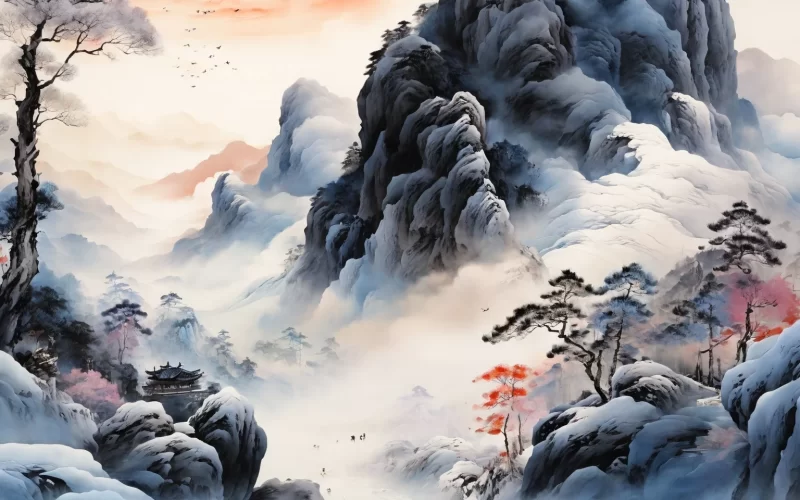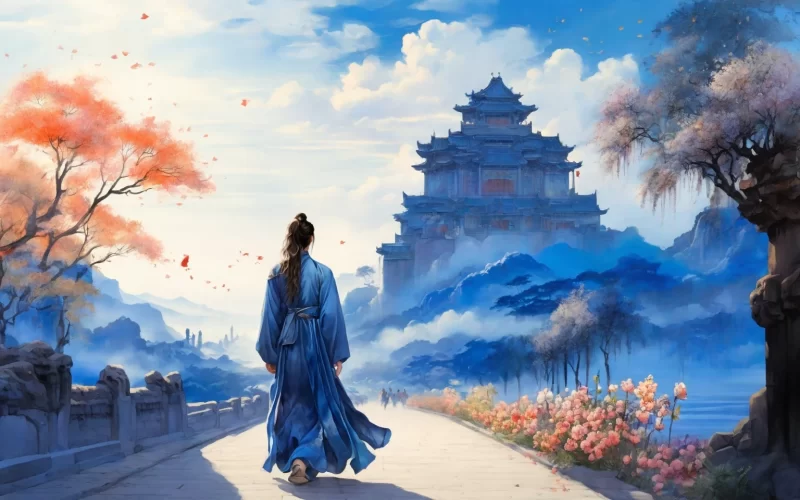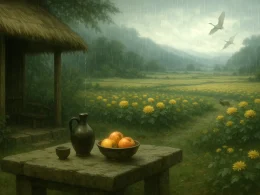Long, long the pathway to Cold Hill;
Drear, drear the waterside so chill.
Chirp, chirp, I often hear the bird;
Mute, mute, nobody says a word.
Gust by gust winds caress my face;
Flake on flake snow covers all trace.
From day to day the sun won't swing;
From year to year I know no spring.
Original Poem
「杳杳寒山道」
寒山
杳杳寒山道,落落冷涧滨。
啾啾常有鸟,寂寂更无人。
淅淅风吹面,纷纷雪积身。
朝朝不见日,岁岁不知春。
Interpretation
This poem was composed during the Tang Dynasty by Han Shan, a renowned monk-poet of the Zhenguan era who secluded himself in Hanyan Temple on Mount Tiantai. His poetry often depicts mountain scenery, personal reflections, and Buddhist insights. Legend holds that he wrote over 600 poems, many inscribed on rocks, bamboo, and wood, circulating among the people. His style is ethereal and sparse, marked by a distinct reclusive spirit and transcendent philosophy. "The Remote Path of Cold Mountain" is a quintessential example of Han Shan's poetic voice, portraying his idealized world of seclusion while reflecting his detachment from worldly affairs.
First Couplet: « 杳杳寒山道,落落冷涧滨。 »
Yǎo yǎo hán shān dào, luò luò lěng jiàn bīn.
Endless stretches the path through Cold Mountain, Desolate, desolate the stream’s icy rim.
The opening couplet employs reduplicated words—"yǎo yǎo" (杳杽, "endless") and "luò luò" (落落, "desolate")—to create a rhythmic cadence, evoking the path’s profound isolation. The poet’s stark natural imagery immerses readers in a frigid, silent mountain realm, setting the tone for the entire poem.
Second Couplet: « 啾啾常有鸟,寂寂更无人。 »
Jiū jiū cháng yǒu niǎo, jì jì gèng wú rén.
Chirping, chirping—birds frequent these heights; Hushed, hushed—no trace of human life.
Here, "jiū jiū" (啾啾, "chirping") contrasts with "jì jì" (寂寂, "hushed"), using sound to amplify silence. Though birdsong lingers, the absence of human presence deepens the solitude, mirroring the poet’s renunciation of worldly clamor.
Third Couplet: « 淅淅风吹面,纷纷雪积身。 »
Xī xī fēng chuī miàn, fēn fēn xuě jī shēn.
Soughing, soughing—wind scours my face; Swirling, swirling—snow piles on my robe.
Shifting to tactile and auditory senses, these lines depict the mountain’s biting wind and snow, embodying both nature’s severity and the ascetic’s endurance. The storm’s whirling void mirrors the poet’s purified mind.
Fourth Couplet: « 朝朝不见日,岁岁不知春。 »
Zhāo zhāo bú jiàn rì, suì suì bù zhī chūn.
Dawn after dawn—no sun breaks through; Year upon year—spring goes unseen.
The reduplicated "zhāo zhāo" (朝朝, "dawn after dawn") and "suì suì" (岁岁, "year upon year") stretch time into oblivion. The poet, indifferent to seasons, dissolves into the mountain’s timeless solitude, transcending earthly attachments.
Holistic Appreciation
This five-character ancient poem embodies a transcendent vision and an austere, chilling style. It paints the desolate beauty of Cold Mountain's depths—from shadowed paths and lonely streams to birdsong amid wind and snow, then to the dissolution of time and seasons. Layer by layer, it progresses, blending exquisite natural imagery with profound emotional resonance. With sparse yet potent strokes, the poet renders the mountain's frigid solitude, using emptiness and stillness to convey detachment from worldly dust. Within this seemingly harsh and isolated realm lies the poet's pursuit of spiritual clarity—his indifference to fame and fortune, his yearning for inner peace, and his devotion to spiritual practice.
Artistic Merits
This poem inherits the stylistic tradition of Six-Dynasties folk ballads, employing deceptively simple yet profoundly expressive language. While each line reads as natural speech, it carries profound resonance. Its most striking feature is the masterful use of reduplicated words—"yǎoyǎo" (杳杳), "luòluò" (落落), "jiūjiū" (啾啾), "jìjì" (寂寂), "xīxī" (淅淅), "fēnfēn" (纷纷), "zhāozhāo" (朝朝), and "suìsuì" (岁岁)—which enhance both the poem's rhythmic musicality and its sensory richness. These repetitions intensify the atmospheric depth and psychological texture. The entire poem interweaves concrete and abstract elements, stillness and motion, using serene natural imagery to reflect the poet's transcendent solitude and spiritual purity. This technique creates the distinctive ethereal quality and Zen-like contemplation characteristic of Han Shan's poetry.
Insights
This poem offers profound spiritual enlightenment: Beyond the clamor and restlessness of worldly existence, there exists another way of life—one that breathes with nature and communes with silence. Through the wintry landscapes of Cold Mountain, Han Shan expresses both his detachment from mundane conflicts and his pursuit of an untainted inner purity. This philosophy of serene indifference inspires us to seek inner equilibrium and spiritual anchorage amidst modern life's turbulence. To maintain the clarity and tranquility embodied in the lines "Dawn after dawn—no sun breaks through; Year upon year—spring goes unseen" is to arrive at one's own interior Cold Mountain—a sanctuary of the soul.
Poem translator
Xu Yuanchong (许渊冲)
About the Poet
Han Shan, also known as Master Han Shan, is traditionally said to have lived during the Zhenguan era (627-649 CE) of the Tang Dynasty, though some sources suggest he may have been active later during the Dali period (766-779 CE). He resided in the cold cliffs of Shifeng County (present-day Tiantai, Zhejiang). A monk who delighted in composing poems and Buddhist gathas, he formed a friendship with the monk Shi De of Guoqing Temple. His poetry, characterized by its vernacular style, bears resemblance to that of Wang Fanzhi. Over 300 of his poems have survived and were later compiled into The Collected Poems of Master Han Shan.











